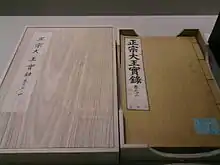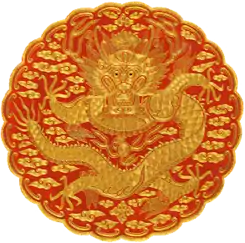Veritable Records of the Joseon Dynasty
The Veritable Records of the Joseon Dynasty (also known as the Annals of the Joseon Dynasty or The True Record of the Joseon Dynasty; Korean: 조선왕조실록 (South Korea) or 조선봉건왕조실록 (North Korea)[2]) are the annual records of the Joseon Dynasty of Korea, which were kept from 1413 to 1865. The annals, or sillok, comprise 1,893 volumes and are thought to cover the longest continual period of a single dynasty in the world. With the exception of two sillok compiled during the colonial era, the Annals are the 151st national treasure of Korea and listed in UNESCO's Memory of the World registry.
| Veritable Records of the Joseon Dynasty | |
 Veritable Records of Jeongjo | |
| Korean name | |
|---|---|
| Hangul | |
| Hanja | |
| Revised Romanization | Joseon Wangjo Sillok |
| McCune–Reischauer | Chosŏn Wangjo Sillok[1] |
| North Korea name | |
| Hangul | |
| Hanja | |
| Revised Romanization | Joseon Bonggeon Wangjo Sillok |
| McCune–Reischauer | Chosŏn Bonggŏn Wangjo Sillok |
The Annals has since 2006 been digitalized by the National Institute of Korean History[3] and available on the internet with Modern Korean translation in Hangul and original text in Classical Chinese.[4] In January 2012, the National Institute of Korean History announced that they are to translate the Annals into English by the year 2033. They plan to start work in 2014 with an initial budget of ₩500 million, but estimate that a budget of ₩40 billion is needed to complete the project.[5]
Compilation
During the reign of a king, professional historiographers maintained extensive records on national affairs and the activities of the state. They collected documents and wrote daily accounts that included state affairs as well as diplomatic affairs, the economy, religion, meteorological phenomena, the arts, and daily life, among other things. These daily accounts became the Sacho ("Draft History"). Great care was taken to ensure the neutrality of the historiographers, who were also officials with legal guarantees of independence. Nobody was allowed to read the Sacho, not even the king, and any historiographer who disclosed its contents or changed the content could be punished with beheading. These strict regulations lend great credibility to these records.[6] Yet at least one king, tyrannical Yeonsangun looked into the Annals, and this led to the First Literati Purge of 1498, in which one recorder and five others were cruelly executed because of what was written in the Sacho. This incident led to greater scrutiny to prevent the king from seeing the Annals. In the Later Joseon period when there was intense conflict between different political factions, revision or rewriting of sillok by rival factions took place, but they were identified as such, and the original version was preserved.
The original recorders recorded every word and act of the king in the Sacho although not all details were included in the final version. For instance, King Taejong fell from a horse one day and immediately told those around him not to let a recorder know about his fall. A recorder wrote both Taejong's fall and his words not to record it. In another instance, Taejong was recorded to complain about a recorder who eavesdropped on him behind a screen and followed him to a hunt behind a disguise.
Upon the death of a king and the coronation of his successor, the Sillokcheong ("Office for Annals Compilation") used the Sacho to begin compilation of his annals.
The Annals of the first three kings of the Joseon dynasty, those of Taejo (r.1392–1398), Jeongjong (r.1399–1400), and Taejong (r. 1401–1418), were hand-written manuscripts. Later annals, from the Annals of Sejong (r. 1418–1450) onwards, were printed with movable metal and wooden type, which was unprecedented in the making of annals in Japan and China.
Four separate repositories were established in Chunchugwan, Chungju County, Jeonju County, and Seongju County to store copies of the Annals. All but the repository in Jeonju were burned down during the Imjin wars. After the war, five more copies of the Annals were produced and stored in Chunchugwan and the mountain repositories of Myohyang-san, Taebaeksan, Odaesan, and Mani-san. The Chunchugwan copy was lost in 1624, due to the treason of Yi Gwal. Part of the Mani-san copy was lost during the Manchu invasion (1636), and the surviving volumes moved to Jeongjok-san in 1678. The Myohyang-san copy was moved to Jeokseong-san in 1633. During the colonial era, the Japanese moved the Odae-san copy to Tokyo University, but most of the copy was soon lost in the Great Kantō earthquake of 1923. 47 books have remained, and in July 2006, the copy returned to South Korea.
The Annals are written in Classical Chinese; they were translated into modern Korean in the 1980s in North Korea and in 1994 in South Korea. Parts of the Annals of the Joseon Dynasty have been scanned by Seoul National University and are available online.
Excluded annals from the collection
The annals of the last two Joseon rulers, Gojong sillok and Sunjong sillok, have been excluded from the Annals of the Joseon Dynasty. The Gojong sillok ends on July 19, 1907 (when Gojong abdicated), while Sunjong sillok ends on August 29, 1910 (the time when the Japan–Korea Treaty of 1910 becoming effective). There's also an "addendum" Sunjong sillok bulok (순종실록부록) which ends on July 6, 1928, when, according to the tradition, the Spirit tablets of late Sunjong and Empress Sunmyeong were placed into Jongmyo as the filial mourning (for the death of Emperor Sunjong) was due.
Written during the Japanese occupation of Korea, Gojong sillok and Sunjong sillok are regarded as "unreliable documents" by Korean academics because of the influence of Japanese officials on their compilation as well as the falsification of historical events. Although they have been included in the National Institute of Korean History's modern Korean translation as the Annals of the Last Two Emperors of the Joseon Dynasty, they are not considered part of the Annals of the Joseon Dynasty and are not included in the National Treasures of South Korea or UNESCO's Memory of the World register.[7][8][9]
Contents
| title | Hangul | Hanja | Volume No. (gwon) | Book No. (chaek) | end of reign compilation | kings | notes | |
|---|---|---|---|---|---|---|---|---|
| 1 | Veritable Records of Taejo | 태조실록 | 太祖實錄 | 15 | 3 | 1398 - 1413 | Taejo | |
| 2 | Veritable Records of Jeongjong | 정종실록 | 定宗實錄 | 6 | 1 | 1400 - 1426 | Jeongjong | |
| 3 | Veritable Records of Taejong | 태종실록 | 太宗實錄 | 36 | 16 | 1418 - 1431 | Taejong | |
| 4 | Veritable Records of Sejong | 세종실록 | 世宗實錄 | 163 | 67 | 1450 - 1454 | Sejong | |
| 5 | Veritable Records of Munjong | 문종실록 | 文宗實錄 | 13 | 6 | 1452 - 1455 | Munjong | |
| 6 | Veritable Records of Danjong | 단종실록 | 端宗實錄 | 14 | 6 | 1455 - 1469 | Danjong | Changed name from Diary of Nosangun (노산군일기, 魯山君日記) in 1698 |
| 7 | Veritable Records of Sejo | 세조실록 | 世祖實錄 | 49 | 18 | 1468 - 1471 | Sejo | |
| 8 | Veritable Records of Yejong | 예종실록 | 睿宗實錄 | 8 | 3 | 1469 - 1472 | Yejong | |
| 9 | Veritable Records of Seongjong | 성종실록 | 成宗實錄 | 297 | 47 | 1494 - 1499 | Seongjong | |
| 10 | Diary of Yeonsangun | 연산군일기 | 燕山君日記 | 63 | 17 | 1506 - 1509 | Yeonsangun | |
| 11 | Veritable Records of Jungjong | 중종실록 | 中宗實錄 | 105 | 53 | 1544 - 1550 | Jungjong | |
| 12 | Veritable Records of Injong | 인종실록 | 仁宗實錄 | 2 | 2 | 1545 - 1550 | Injong | |
| 13 | Veritable Records of Myeongjong | 명종실록 | 明宗實錄 | 34 | 21 | 1567 - 1571 | Myeongjong | |
| 14 | Veritable Records of Seonjo | 선조실록 | 宣祖實錄 | 221 | 116 | 1608 - 1616 | Seonjo | |
| Veritable Records of Seonjo (revision) | 선조수정실록 | 宣祖修訂實錄 | 42 | 8 | 1657 | |||
| 15 | Diary of Gwanghaegun | 광해군일기 | 光海君日記 | 187 | 64 | 1623 - 1633 | Gwanghaegun | |
| 187 | 40 | 1653 | ||||||
| 16 | Veritable Records of Injo | 인조실록 | 仁祖實錄 | 50 | 50 | 1649 - 1653 | Injo | |
| 17 | Veritable Records of Hyojong | 효종실록 | 孝宗實錄 | 21 | 22 | 1659 - 1661 | Hyojong | |
| 18 | Veritable Records of Hyeonjong | 현종실록 | 顯宗實錄 | 22 | 23 | 1674 - 1677 | Hyeonjong | |
| Veritable Records of Hyeonjong (revision) | 현종개수실록 | 顯宗改修實錄 | 28 | 29 | 1683 | |||
| 19 | Veritable Records of Sukjong | 숙종실록 | 肅宗實錄 | 65 | 73 | 1720 - 1728 | Sukjong | |
| 20 | Veritable Records of Gyeongjong | 경종실록 | 景宗實錄 | 15 | 7 | 1724 - 1732 | Gyeongjong | |
| Veritable Records of Gyeongjong (revision) | 경종수정실록 | 景宗修訂實錄 | 5 | 3 | 1781 | |||
| 21 | Veritable Records of Yeongjo | 영조실록 | 英祖實錄 | 127 | 83 | 1776 - 1781 | Yeongjo | Renamed from Veritable Records of Yeongjong (영종실록, 英宗實錄) in 1899 |
| 22 | Veritable Records of Jeongjo | 정조실록 | 正祖實錄 | 54 | 56 | 1800 - 1805 | Jeongjo | Renamed from Veritable Records of Jeongjong (정종실록, 正宗實錄) in 1899 |
| 23 | Veritable Records of Sunjo | 순조실록 | 純祖實錄 | 34 | 36 | 1834 - 1838 | Sunjo | Renamed from Veritable Records of Sunjong (순종실록, 純宗實錄) in 1899 |
| 24 | Veritable Records of Heonjong | 헌종실록 | 憲宗實錄 | 16 | 9 | 1849 - 1851 | Heonjong | |
| 25 | Veritable Records of Cheoljong | 철종실록 | 哲宗實錄 | 15 | 9 | 1853 - 1865 | Cheoljong | |
| 26 | Veritable Records of Gojong | 고종실록 | 高宗實錄 | 52 | 52 | 1907 - 1934 | Gojong | Often excluded from the collection by Korean academics |
| 27 | Veritable Records of Sunjong | 순종실록 | 純宗實錄 | 22 | 8 | 1910 - 1934 | Sunjong |
References
- "Korean McCune-Reischauer Romanization Dictionary". Archived from the original on 2010-09-29. Retrieved 2009-04-24.
- "력사에 류례없는 구출작전". Uriminzokkiri (in Korean). Archived from the original on 2019-07-01. Retrieved 2019-07-01.
- "E-Annals Bring Chosun History to Everyman". Chosun Ilbo. 27 January 2006. Retrieved 16 October 2012.
- "The Annals of the Choson Dynasty". The Annals of the Choson Dynasty. Retrieved 14 June 2015.
- Lee Sun-min; Ha Hyun-ock (16 January 2012). "Annals of the Joseon Dynasty to be translated". Joongang Daily. Archived from the original on 11 April 2013. Retrieved 29 March 2013.
- "Summary of the Annals of the Choson Dynasty". National Institute of Korean History. Retrieved 2009-05-27.
- "About the Annals of Last Two Emperors of the Choson Dynasty". National Institute of Korean History. Retrieved 2009-05-27.
- Yu Seok-jae (유석재) (2007-01-14). "고종·순종실록의 '찜찜한' 인터넷 공개". The Chosun Ilbo.
- Jae-un Kang; Suzanne Lee; Sook Pyo Lee (2006). The Land of Scholars: Two Thousand Years of Korean Confucianism. Homa & Sekey Books. pp. 218–219. ISBN 1-931907-30-7.
External links
- Official Site (in Korean) (South Korean gov't)
- Veritable Records of the Ming Dynasty, Joseon Dynasty & Qing Dynasty (Academia Sinica)(in Chinese)
- Kyujanggak Online : The 5th column lists Annals of the Joseon Dynasty
- Annals of the Choson Dynasty-UNESCO Memory of the World Register
